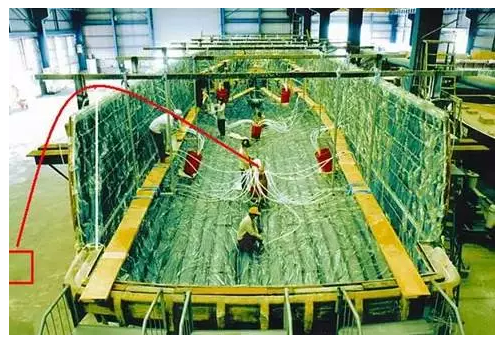Resin vacuum suction method for FRP ships
Date:2020-04-13Source:Views:
Glass fiber reinforced plastic (FRP) is a new kind of composite material made in ships in the late 1960s, which has the characteristics of light weight, high strength, corrosion resistance and strong plasticity. After decades of development, FRP materials have been widely used in the construction of small and medium-sized boats, especially yachts, high-speed boats and tourist ships have been widely used in recent years. This paper mainly introduces a new process of glass fiber reinforced plastic (FRP) ship construction and molding —— Resin vacuum suction method.

1. Brief introduction
Resin vacuum suction method is spreading reinforced fiber materials on the rigid mold in advance. Then vacuum bag and drawing out the air inside to form a negative pressure in the mold cavity. Making use of the vacuum pressure to suck the unsaturated resin into a fiber layer through prepared pipe and wetting the fiber material, finally fulfilling the whole mold. After curing, vacuum bag material is uncovered, demoulding of the mould to get the required product.
The vacuum suction process is a new large-sized boat forming and construction technology, which uses a closed system in a single-sided rigid mold. The process was patented in 1950 and was not introduced in China until around 2000. As this process is introduced from abroad, there are also a variety of names in naming, such as vacuum introduction, vacuum perfusion, vacuum injection.
2. Principle
The vacuum suction method is based on the hydraulic theory established in 1855 by the French hydraulician Darcy, known as Darcy's law: T=2HL/(2k (AP)). T is the resin import time, which is determined by 4 parameters. H is the viscosity of the resin, which guides the viscosity of the resin. Z is the inlet length, and refers to the distance between the resin inlet and the outlet. AP refers to the pressure difference between inside and outside the vacuum bag. K is the permeability, refers to the glass fiber, sandwich material and other parameters of resin infiltration. According to Darcy's law, the lead-in time of the resin in the vacuum lead-in process is proportional to the length and viscosity of the resin, and inversely proportional to the pressure difference between the inside and outside of the vacuum bag and the permeability of the fiber.
3. Process
Preparation
Coat the hull
Lay reinforcing material
Lay vacuum materials
Draw out the air
Deploy resin proportion
Pump resin into mold
Solidified stripping outfitting
4. Conclusion
As a new type of glass fiber reinforced plastic (FRP) ship forming and construction technology, Resin vacuum suction method has many advantages. Especially in the construction of large scale, high speed, strong strength of the ship, it has its irreplaceable role. With the continuous improvement of the construction process and the reduction of the cost of raw materials, as well as the increasing social demand, the construction of FRP ships will gradually transition to the mechanical molding process, and the resin vacuum introduction method will be widely used in more factories.
